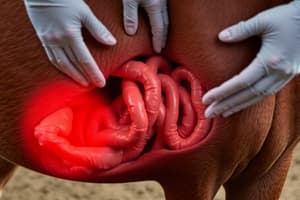Podcast
Questions and Answers
Which of the following analgesics has the longest duration of effect?
Which of the following analgesics has the longest duration of effect?
- Xylazine
- Detomidine flunixin
- Butorphanol
- Flunixin meglumine (correct)
Which analgesic is NOT recommended for a horse with colic and tachycardia?
Which analgesic is NOT recommended for a horse with colic and tachycardia?
- Flunixin meglumine
- Buscolysin (Hyoscine Butylbromide)
- Analgin
- Butorphanol (correct)
Which drug is a spasmolytic and NOT an analgesic?
Which drug is a spasmolytic and NOT an analgesic?
- Analgin
- Phenylbutazone
- Buscolysin (Hyoscine Butylbromide) (correct)
- Flunixin meglumine
Which drug is commonly used to treat pain in horses with colic and tachycardia?
Which drug is commonly used to treat pain in horses with colic and tachycardia?
Which imaging projection is best for detecting osteochondral fragments along the medial maleolus of the tibia?
Which imaging projection is best for detecting osteochondral fragments along the medial maleolus of the tibia?
What does the sagittal ratio serve for determining in horses?
What does the sagittal ratio serve for determining in horses?
What is the frequency of a horse's fecal balls per day?
What is the frequency of a horse's fecal balls per day?
What does the auscultation of a horse's abdomen reveal in case of delayed intestinal motility?
What does the auscultation of a horse's abdomen reveal in case of delayed intestinal motility?
What does Tyndall effect represent in equine recurrent uveitis?
What does Tyndall effect represent in equine recurrent uveitis?
Which of the following is the correct description of Tyndall effect observed in equine recurrent uveitis?
Which of the following is the correct description of Tyndall effect observed in equine recurrent uveitis?
What is the most typical sign of osteochondrosis?
What is the most typical sign of osteochondrosis?
What does it indicate when a horse touches the ground with the left thoracic hoof first with the toe?
What does it indicate when a horse touches the ground with the left thoracic hoof first with the toe?
What blood laboratory parameters are urgently needed in a horse with colic?
What blood laboratory parameters are urgently needed in a horse with colic?
What does an enlarged, atonic, fluid-filled small intestinal folds mean on transabdominal ultrasound in a horse?
What does an enlarged, atonic, fluid-filled small intestinal folds mean on transabdominal ultrasound in a horse?
What is NOT a predilection site for osteochondrosis?
What is NOT a predilection site for osteochondrosis?
Flashcards are hidden until you start studying
Study Notes
Analgesic with Longest Duration
- Flunixin meglumine has the longest duration of effect among analgesics.
Analgesic NOT Recommended for Colic and Tachycardia
- Flunixin meglumine is contraindicated in horses with colic and tachycardia due to its potential to exacerbate cardiac problems.
Spasmolytic NOT Analgesic
- Glycopyrrolate is a spasmolytic that relaxes smooth muscle but does not have analgesic properties.
Drug for Colic and Tachycardia
- Butorphanol is commonly used to treat pain in horses with colic and tachycardia as it provides analgesia without the cardiovascular risks associated with other NSAIDs.
Imaging Projection for Medial Maleolus
- Dorsal-Palmar/Plantar Oblique projection is ideal for examining osteochondral fragments along the medial maleolus of the tibia.
Sagittal Ratio's Function
- The sagittal ratio is used to assess the shape of the horse's hoof and identify any potential lameness issues caused by hoof deformities.
Frequency of Fecal Balls
- Horses typically pass 8-12 fecal balls per day, with variations depending on factors like diet and hydration.
Abdomen Auscultation with Delayed Motility
- Auscultation of a horse's abdomen reveals reduced or absent bowel sounds in case of delayed intestinal motility, indicative of potential colic.
Tyndall Effect in Equine Recurrent Uveitis
- Tyndall effect, observed in equine recurrent uveitis, represents the presence of inflammatory cells and protein in the aqueous humor of the eye.
Tyndall Effect Description
- The Tyndall effect in equine recurrent uveitis is the presence of light scattering in the aqueous humor due to the presence of inflammatory cells and protein.
Most Typical Sign of Osteochondrosis
- Lameness is the most common clinical sign of osteochondrosis, often accompanied by swelling in affected joints.
Meaning of Left Thoracic Hoof Touching First with Toe
- When a horse touches the ground with the left thoracic hoof first with the toe, it indicates weight-bearing asymmetry and potential lameness in the left forelimb.
Urgent Blood Parameters for Colic
- Blood laboratory parameters urgently needed in a horse with colic include:
- Complete blood count (CBC)
- Biochemistry profile
- Lactate levels
- Blood gas analysis.
Enlarged Atonic Fluid-Filled Small Intestinal Folds
- Enlarged, atonic, fluid-filled small intestinal folds observed on transabdominal ultrasound in a horse suggest a possible cause of colic, specifically small intestinal ileus.
Predilection Sites for Osteochondrosis
- The distal radius and the medial femoral condyle are not common predilection sites for osteochondrosis in horses.
Studying That Suits You
Use AI to generate personalized quizzes and flashcards to suit your learning preferences.




